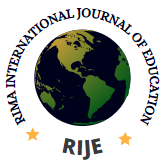Service Learning in 21st Century: The Role of Emerging Technologies on Today’s Preservice Teacher Education
Hassan Aliyu & Aliyu Garba
Department of Science Education, Sokoto State University, Sokoto, Nigeria. Email: nagoronyo@gmail.com ; ORCID: 0000-0003-4929-3126
Abstract
This study explores the integration of emerging technologies in service learning within preservice teacher education, highlighting its significance in preparing future educators for the demands of 21st-century classrooms. Service learning, which combines academic learning with community engagement, is examined as a powerful pedagogical approach that fosters critical thinking, cultural competence, and social responsibility. The research identifies various emerging technologies, such as virtual reality, artificial intelligence, and collaborative online platforms that enhance the service-learning experience by facilitating access to resources, promoting communication, and enabling innovative pedagogical practices. However, the study also addresses challenges faced by preservice teachers, including inadequate institutional support, ethical concerns regarding data privacy, and the rapid evolution of technology. The study discusses the importance of a collaborative effort among educators, institutions, and technology developers to create a robust framework for service learning that influences technology effectively, thereby enriching teacher education and fostering a more equitable educational landscape for all students.
Keywords
Service Learning, Emerging Technologies, Preservice Teacher Education, Community Engagement, Pedagogical Practices
Reference
Abidin, Z. Z., Budayasa, I. K., & Khabibah, S. (2021). Reflective Practice of Pre-Service Mathematics Teacher on Online Learning. Journal of Physics Conference Series (Vol. 1957, Issue 1, p. 12004). IOP Publishing. https://doi.org/10.1088/1742-6596/1957/1/012004
Afifah, D. N., & Wirza, Y. (2021). An Investigation into Foreign Pre-Service Teacher’s Intelligibility in an International Teaching Program. Education and Humanities Research/Advances in social science, education and humanities research. https://doi.org/10.2991/assehr.k.210427.021
Ahmad, S., Umirzakova, S., Mujtaba, G., Amin, M., & Whangbo, T. K. (2023). Education 5.0. https://export.arxiv.org/pdf/2307.15846v1.pdf
Al‐Samarraie, H., & Saeed, N. (2018). A systematic review of cloud computing tools for collaborative learning: Opportunities and challenges to the blended-learning environment [Review of A systematic review of cloud computing tools for collaborative learning: Opportunities and challenges to the blended-learning environment]. Computers & Education, 124, 77. Elsevier BV. https://doi.org/10.1016/j.compedu.2018.05.016
Altwoyan, W., & Alsukayti, I. S. (2022). A Novel IoT Architecture for Seamless IoT Integration into University Systems. International Journal of Advanced Computer Science and Applications (Vol. 13, Issue 4). Science and Information Organization. https://doi.org/10.14569/ijacsa.2022.0130413
Andrews, D. J. C., & Richmond, G. (2019). Professional Development for Equity: What Constitutes Powerful Professional Learning? Journal of Teacher Education (Vol. 70, Issue 5, p. 408). SAGE Publishing. https://doi.org/10.1177/0022487119875098
Becton, Y. J., Bogiages, C., D’Amico, L. K., Lilly, T., Currin, E., Jeffries, R., & Tamim, S. R. (2020). An Emerging Framework for the EdD Activist. Impacting Education Journal on Transforming Professional Practice (Vol. 5, Issue 2, p. 43). University Library System, University of Pittsburgh. https://doi.org/10.5195/ie.2020.131
Benedicto, P. N., & Andrade, R. (2022). Problem-Based Learning Strategies and Critical Thinking Skills Among Pre-Service Teachers. International Journal of Science Technology Engineering and Mathematics (Vol. 2, Issue 2, p. 1). https://doi.org/10.53378/352885
Borgerding, L. A., & Caniglia, J. (2017). Service Learning Within a Secondary Math and Science Teacher Education Program: Preservice MAT Teachers’ Perspectives. School Science and Mathematics (Vol. 117, Issue 1, p. 63). Wiley. https://doi.org/10.1111/ssm.12210
Bringle, R. G., & Clayton, P. H. (2021). Civic Learning: A Sine Qua Non of Service Learning. Frontiers in Education (Vol. 6). Frontiers Media. https://doi.org/10.3389/feduc.2021.606443
Brown, C. P., Barry, D. P., Ku, D. H., & Puckett, K. (2020). Teach as I Say, Not as I Do: How Preservice Teachers Made Sense of the Mismatch between How They Were Expected to Teach and How They Were Taught in Their Professional Training Program. The Teacher Educator (Vol. 56, Issue 3, p. 250). Taylor & Francis. https://doi.org/10.1080/08878730.2020.1847225
Çakıroğlu, Ü., & Erdemir, T. (2018). Online project based learning via cloud computing: exploring roles of instructor and students. Interactive Learning Environments (Vol. 27, Issue 4, p. 547). Taylor & Francis. https://doi.org/10.1080/10494820.2018.1489855
Cao, J., Bhuvaneswari, G., Arumugam, T., & Aravind, B. R. (2023). The digital edge: examining the relationship between digital competency and language learning outcomes. Frontiers in Psychology (Vol. 14). Frontiers Media. https://doi.org/10.3389/fpsyg.2023.1187909
Cao, W., & Yu, Z. (2023). The impact of augmented reality on student attitudes, motivation, and learning achievements—a meta-analysis (2016–2023). Humanities and Social Sciences Communications (Vol. 10, Issue 1). Palgrave Macmillan. https://doi.org/10.1057/s41599-023-01852-2
Caspari-Sadeghi, S. (2022). Learning assessment in the age of big data: Learning analytics in higher education. Cogent Education (Vol. 10, Issue 1). Taylor & Francis. https://doi.org/10.1080/2331186x.2022.2162697
Cavendish, W., Perez, X., & Mahotiere, M. (2020). Pre-Service Teacher Supports in Urban Schools. Action in Teacher Education (Vol. 43, Issue 1, p. 54). Taylor & Francis. https://doi.org/10.1080/01626620.2020.1776175
Cook, H., Apps, T., Beckman, K., & Bennett, S. (2023). Digital competence for emergency remote teaching in higher education: understanding the present and anticipating the future. Educational Technology Research and Development (Vol. 71, Issue 1, p. 7). Springer Science+Business Media. https://doi.org/10.1007/s11423-023-10194-4
